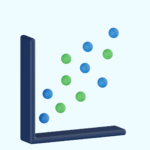Why Run Bivariate Analyses?
In quantitative studies, researchers often have highly specific research questions and know exactly which variables to examine. I recommend this approach because setting the methodology and data analysis plan in stone as early as possible is important. You need to have a step-by-step list of how you plan to analyze your data. However, if you have more open-ended research questions or haven’t agreed upon a final set of variables, then you may be resorting to “fishing for significance”. This is many times a frowned-upon approach in the world of statistics. It essentially means that you are casting a wide-net and hoping to find statistically significant results. When dealing with archival data sets or examining a large list of potential predictor variables, sometimes there isn’t really an alternative.
Building Predictive Models
If you are attempting to build predictive models such as regressions, then bivariate tests can be conducted first to establish which variables are statistically significant with the dependent (outcome) variable. There are several bivariate analyses that can be run based on the level of measurement for your variables of interest:
- Pearson correlations – if your potential predictors and dependent variable are continuous measurements (interval).
- Spearman correlations – If your potential predictors or dependent variable are ordinal measurements.
- Point-biserial correlation – if you have a combination of binary and continuous (interval) measurements.
- Chi-square test of independence – if your potential predictors and dependent variable are nominal measurements.
Based on the results of these bivariate analyses, you can then place the significant variables into a regression model and analyze the collective model fit and strength of the individual predictors. This is a more organized and structured way of building regression models instead of inputting 20+ predictors into the model at once. It allows you to narrow the regression model down because you are eliminating variables that do not have a two-way association with the dependent variable.
Additional Resources:
Correlation (Pearson, Kendall, Spearman)
Confidently Conduct and Interpret Correlation Tests

We work with graduate students every day and know what it takes to get your research approved.
- Address committee feedback
- Roadmap to completion
- Understand your needs and timeframe
